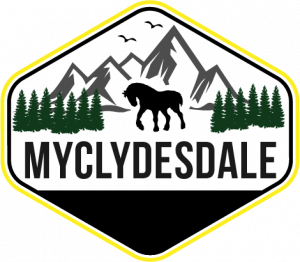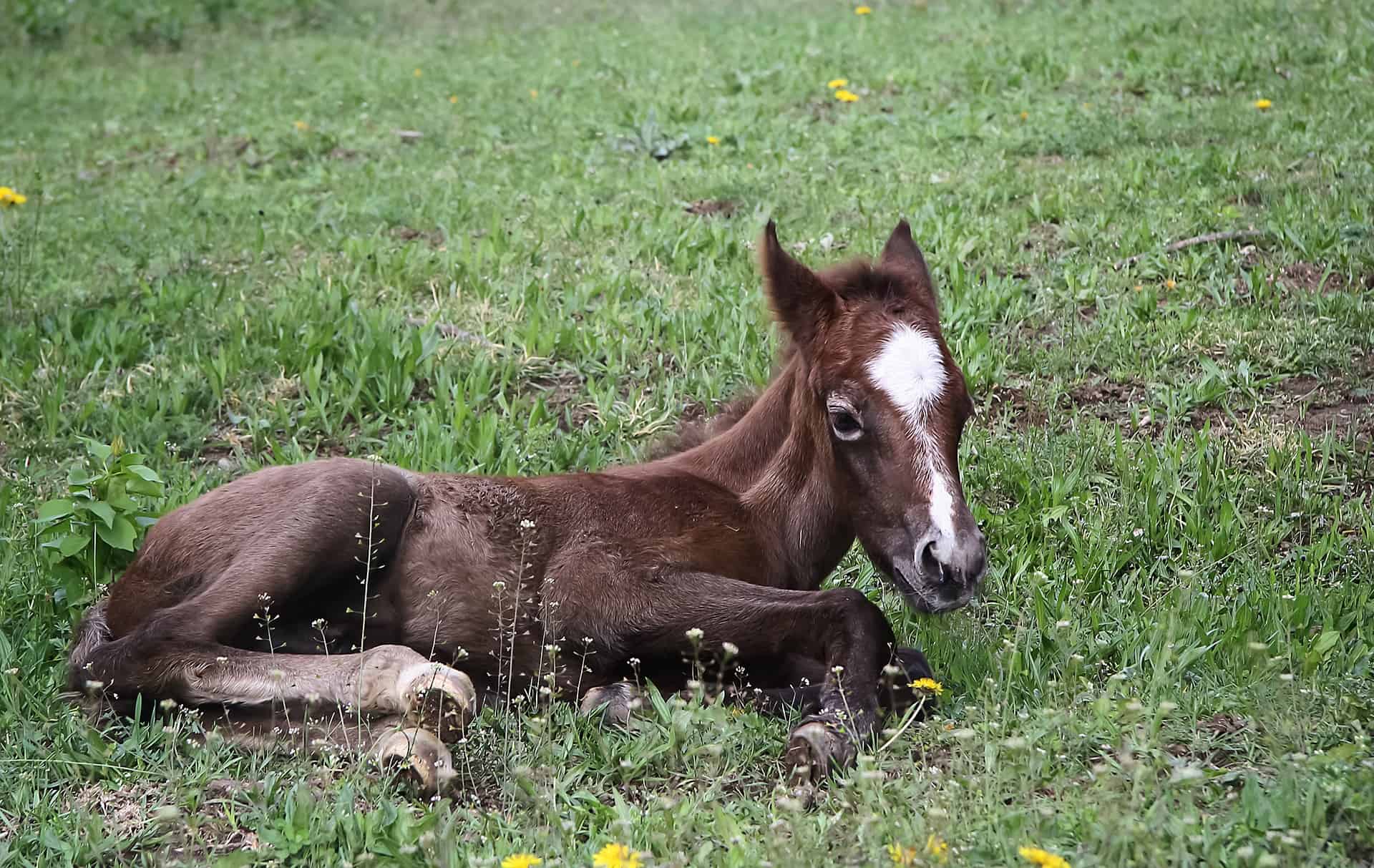Clydesdale horses are draft horses that were developed from the extraordinarily devoted farm horses of Clydesdale (now Lanarkshire), Scotland. By horse breeding a Flemish stallion with local mares around the year 1715, the breed was enhanced. Around 1842, Clydesdales were imported to North America but never gained popularity as draft horses.
The Clydesdale horse breeds weighs 2,000 pounds on average and stands 68 to 72 inches tall. Typically bay, dark brown, or black in color with noticeable white patterns. The breed is distinguished by feathers (long hair) on the legs, handsome heads, and well-formed legs and feet. It is known for its high leg motion while walking or trotting.
Similar to other horse breeds, these animals thrive in herds and have a gregarious character. They require expansive pastures with an abundance of grass to eat, and you should also add grain and hay to their diet to round out their nutrition. You must also make sure that everyone has constant access to clean water and some kind of shelter. Their maintenance is a little different from that of a typical horse because of their big size. Their increased heft must be reflected in the housing and food requirements.
Clydesdale Horse Breeding

Horse Breeding is and has been around for centuries and maybe some of your favourite breeds may have been naturally or purposefully bred for some reason or another. The Clydesdale is one of our favorites and has been one of the most successful horse breeds in the history of horse breeding. Yet as I write this today they are vulnerable. Their population is extremely low compared to what they were. One-of-a-kind prime horse breeds that we need to look after.
Humans first developed this breed in the early 19th century, and their name was first mentioned in 1826. Breeders established the first Clydesdale Horse Society in 1877, and several other recognized organizations and societies later followed their lineages.
The Clydesdale Horse Society aims to safeguard and improve Clydesdale Horse breeding. According to FAO endangerment criteria, the Clydesdale Horse is classified by the UK Government as a Native Breed at Risk and critically endangered.
aims to safeguard and improve Clydesdale Horse breeding. According to FAO endangerment criteria, the Clydesdale Horse is classified by the UK Government as a Native Breed at Risk and critically endangered.
The Clydesdale Horse Society’s Stud Book lists animals in breeder-by-breeder alphabetical order. According to animal health law, animals will be recognized by the following characteristics:
- Universal Equine Life Number
- Microchip
- Prefix/suffix of the breeder
- The name of the animal
- Animal’s name, color, and markings.
Take a look at Draft Horse For Pleasure Riding
Training A Draft Horse For Pleasure Riding
Clydesdale Reproduction

All horse breeds have similar reproduction rates. Usually, the breeders choose a preferred stallion
have similar reproduction rates. Usually, the breeders choose a preferred stallion to mate with the mare. The mares go through a gestation phase of roughly 11 months after mating. However, this varies significantly. Mares typically produce one foal, or progeny, in the majority of births.
to mate with the mare. The mares go through a gestation phase of roughly 11 months after mating. However, this varies significantly. Mares typically produce one foal, or progeny, in the majority of births.
Early spring is when most foals are born. Clydesdales typically give birth to one foal a year. Foals are typically 3.5 feet (1.1 meters) and 125 pounds at birth (57 kg). Within one to two hours following birth, the afterbirth is typically evacuated. Within hours of birth, mares can recognize their calves. The main identifying characteristic is odor. The mare normally smells the foal’s rear area when the most definitive identification is typically achieved.
During its first six months, a foal stays at its mother’s side and develops quickly while nursing. The foal is weaned to a blend of feed and additional nutrients toward the conclusion of that period. Horses have well-developed skeletal and muscular systems that enable a foal to walk and follow its mother within a few hours of birth.
Parturition-related behavioral characteristics in horses have a long evolutionary history. According to a basic premise, horses have evolved behavioral patterns that assure their survival. Both the dam and her young are vulnerable to predators during the birthing process since they are both weaker. The mare takes precautions to increase their safety during parturition. The general steps are finding a secure location for foaling, hastening the procedure, reducing the amount of evidence left behind, and attaining swift recovery.
Foaling Behaviour
Mares seek solitude when giving birth. Mares will try to wait until there are no human spectators present before giving birth. Mares typically give birth at night. According to one study, for instance, 80% of foals were delivered between the hours of midnight and six in the morning.

Taking Care Of A Foal
You should clean out any mucus or debris from a foal’s nostrils as soon as it is born to help it breathe. You should also apply iodine to the umbilical stump to stop bacteria from entering the body, leading to a dangerous blood illness. Within the first one to two hours, the foal should start nursing. This is important because the mare’s colostrum, or first milk, contains antibodies that give the young foal immunity to disease. Replacers for milk can be used when a mare rejects her foal. Within the first two hours, foals should also produce a bowel movement; if not, you must provide an enema to the foal.
As much as possible, avoid disturbing the mare and foal. Since many mares are fiercely protective of their young, someone will probably need to restrain the mare. At the same time, another person takes care of the foal’s requirements, such as cleaning the mucus from the foal’s body and covering the umbilical stump, among other things.
A new foal should be handled for at least 15 minutes daily, including caressing its hooves, ears, nose, and other body parts. You should also tap the foal’s feet and rub them all over. A foal will be much simpler to handle as an adult if it is handled early on.
Vaccinations typically start about three months old, and the recommended booster shots are given one month later. The foal is typically vaccinated against equine influenza between 8 and 10 months. Your veterinary doctor can suggest the optimum immunization schedule for your foal.
Why Buy a Clydesdale Horse?
Nowadays, there are many more reasons to choose a Clydesdale horse than only to perform manual labor alone!
The Clydesdale horse is a fantastic choice for riders of all skill levels because of its calm, easygoing disposition, and Clydesdale horse riding is a well-liked pastime plus equine therapy. They are also a well-liked option for therapy horses because of their stable, dependable, and sure-footed demeanor. They make fantastic family horses and are excellent for trail riding since they are intelligent, quick, and simple to train.
because of their stable, dependable, and sure-footed demeanor. They make fantastic family horses and are excellent for trail riding since they are intelligent, quick, and simple to train.
Drum or parade horses are frequently chosen from Clydesdale horses. The British Household Cavalry also uses the Clydesdale at a number of ceremonial events; however, the Budweiser Clydesdales are likely the best-known example of this.
- Mastering English Dressage: Tips and Techniques Complete Guide 101
- Western Dressage for Beginners: Complete Guide 101
- Clash of Equestrian Cultures: Western vs English Dressage Complete Guide
- What Sets Powerful Clydesdales Apart in Dressage Riding? (Gentle Giants)
- Saddle Up for Success: The Ultimate Guide to Learning How to Ride a Horse 2023
Recent Posts
Mastering English Dressage: Tips and Techniques Complete Guide 101
Introduction English dressage is an equestrian sport that involves precise movements and commands between a dressage horse and its rider. It is a graceful, beautiful art form that requires skill...
Introduction Are you looking to learn more about western dressage, the art of horse dressage? If so, you've come to the right place. In the previous blog we looked at Western vs English Dressage,...

